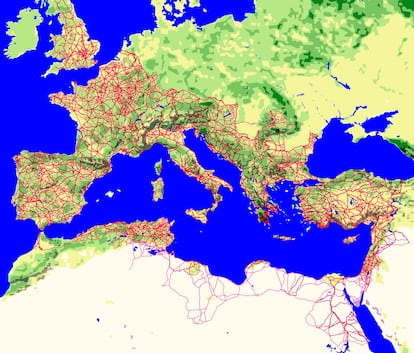The Roman Empire's 'road map' is twice as extensive as previously thought

Modern geographic information systems have identified 299,000 km of Roman roads and highways, combining all existing historical and archaeological sources.

Alongside the legions, milestones marked the power of the Roman Empire . Placed every thousand passus , or Roman miles (1,478.5 meters), these cylindrical or parallelepiped markers punctuated Roman roads, much like kilometer markers do on highways today. A large group of researchers has used cutting-edge technology to delve into historical and archaeological records to reconstruct the road network of 2,000 years ago. What they have discovered is that it was much more extensive, almost twice as large, as previously thought. But they have also found that hardly anything remains of its original route. The results of their work, published in Scientific Data , have been compiled and made available to the public on the Itiner-e website, a digital atlas of the roads that originated or terminated in Rome.
“When you drive along a road badly sunken by time and people, you still hear people say 'it was a Roman road,' but the Romans built them to last,” says Pau de Soto, from the Archaeology Research Group at the Autonomous University of Barcelona (UAB) and lead author of this impressive study. “Another misconception to dispel is that they paved them, like the Appian Way. In reality, they built them with increasingly finer layers of gravel, with the surface layer made of compacted fine gravel. This was the best for horses, which at that time didn't yet wear horseshoes,” the archaeologist adds. As with modern roads, they raised them above the surrounding terrain and had a slight incline to allow for water runoff. “The first modern roads were built following the Romans' methods,” this archaeologist reminds us.

Pau de Soto and some twenty other researchers have used modern GIS (Geographic Information System) techniques to unearth the routes of Roman roads. “GIS is the foundation of modern archaeological research,” says the UAB researcher. They combined historical texts such as the Antonine Itinerary and the Peutinger Table , the closest thing to an ancient road map, with studies of archaeological sites and books on the history of Rome. “But also with topographic maps from the 19th and 20th centuries, photographs taken by Americans of European lands in the postwar period, and satellite images; GIS allows you to combine information from all these sources and map it onto the ground,” adds de Soto.
The result of combining so many sources is that, around the year 150 AD, the Roman Empire—then at its greatest extent, encompassing some four million square kilometers of territory—had 299,171 kilometers of roads. This figure adds more than one hundred thousand kilometers to the 188,555 km calculated in previous studies and is equivalent to circling the globe seven times. In Spain alone, the extent of Roman roads exceeded 40,000 km, doubling the previously assumed amount. At that time, the radial distribution centered on Madrid that characterizes modern highways did not exist, but some of the main roads originated from cities like Augusta Emerita (Mérida), the capital of Roman Lusitania.
The authors of the new study estimate that one-third of the Roman roads connected major urban centers, while the remaining two-thirds were secondary roads, linking local or regional populations. However, they have found that only 2.7% of the total mileage is known with certainty. “This is what is still preserved or has been excavated in archaeological work,” explains de Soto, who adds that for the vast majority of Roman roads—almost 90%—there are only clues that they must have been there: “In the archaeology of passageways, we call them fossilized axes, and these can be a Roman bridge, the remains of a road at the edge of a city, or the discovery of a milestone.” Everything indicates that a road must have connected all these elements. What a GIS does with this information is to imagine the most likely route, taking into account the terrain's topography, such as a mountain pass or river crossing. Another 7% of that total road map would only be hypothetical: if there are two nearby Roman cities with road remains at their exit, it would be expected that they would be joined by one.

“The roads—and the transport network as a whole—were absolutely crucial to the maintenance of the Roman Empire,” says Adam Pažout, a historian at Aarhus University (Denmark) and co-author of the study. “The Romans devised an intricate transport system comprised of inns, way stations, and relay points for messengers and public officials traveling throughout Italy and the provinces,” he explains. According to Pažout, “the roads formed a framework that allowed Roman power to be projected, whether through the army or through law and administration, and that held the Empire together.”
According to the authors, their work will allow for a better understanding of Roman history. Millions of people traveled along the Roman roads, new ideas and beliefs spread, and Roman legions advanced along them, as did trade between the different parts of the three continents that comprised the Roman territory. But these roads, whose vast network is only now being discovered, also facilitated the transmission of diseases and plagues such as the Antonine Plague of smallpox and measles, and the Plague of Justinian of bubonic plague, which weakened the Empire. They may also have served as entry points for successive barbarian invasions.
What remains of the Roman roads, even if they don't physically cover many kilometers, forms part of the framework of Europe. The archaeologist from Soto reminds us: “The European urban fabric is a legacy of Rome. Most European cities already existed in Roman times and were already connected to each other.”
EL PAÍS





